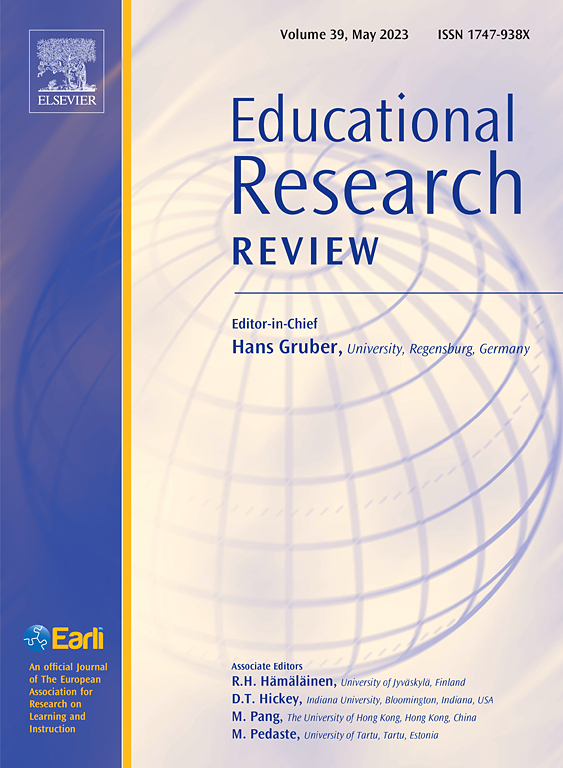Richard Mayer多媒体学习研究的元分析:寻找跨多种媒体类型的设计原则的边界条件
IF 10.6
1区 教育学
Q1 EDUCATION & EDUCATIONAL RESEARCH
引用次数: 0
摘要
Richard E. Ma本文章由计算机程序翻译,如有差异,请以英文原文为准。
A meta-analysis of Richard Mayer's multimedia learning research: Searching for boundary conditions of design principles across multiple media types
Richard E. Ma
yer has made major contributions to Educational Psychology since the 1970s, including work on learning in mathematics, creativity, interest, measurement, problem solving, and especially multimedia learning, defined as learning from instructional material that includes information in both verbal and visual form. In a 2024 reflection, Mayer called for identifying boundary conditions—i.e., moderators of effects—of his multimedia design principles. In an effort to identify these, we meta-analyzed Mayer's corpus of multimedia research. We searched Google Scholar, PsycINFO, and the Cambridge Handbook of Multimedia Learning 3rd Ed. for peer-reviewed articles on multimedia learning with Mayer as an author published 1990–2022 and located 92 articles reporting on 181 studies reporting on 591 separate effects. We coded for 9 moderators: multimedia design principle, multimedia type, age, academic domain, country/continent, treatment duration, dependent variable type, year, and authorship order. We analyzed the Hedge's g effect sizes using a multilevel regression approach in the metafor package in R. The overall effect was g = 0.37, which was significantly moderated by all moderators, including a small decline in effect size per year. Mean effects by multimedia design principle were uneven, with the largest significant effects for removing seductive detail, modality principle, personalization, multimedia principle, sentence-level coherence, and self-explanation. Medium significant overall effects were found for the testing effect, scaffolding, cueing, and embodiment. Large, consistent effects were found for text + diagrams across factual, inferential, and transfer outcomes. Less-consistent effects were found for animation, games, and simulations, with smaller effects on factual learning and on average larger effects on inferential and transfer outcomes, but no significant effects for virtual reality. We identified two boundary conditions in tests of design principle x DV type interactions and Multimedia type x DV type interactions. We close by interpreting various findings in phases of Mayer's work, characterized by collaborators and educational technologies. We also contextualize Mayer's findings within recent meta-analyses of the larger published research on various design principles.
求助全文
通过发布文献求助,成功后即可免费获取论文全文。
去求助
来源期刊

Educational Research Review
EDUCATION & EDUCATIONAL RESEARCH-
CiteScore
19.40
自引率
0.90%
发文量
53
审稿时长
57 days
期刊介绍:
Educational Research Review is an international journal catering to researchers and diverse agencies keen on reviewing studies and theoretical papers in education at any level. The journal welcomes high-quality articles that address educational research problems through a review approach, encompassing thematic or methodological reviews and meta-analyses. With an inclusive scope, the journal does not limit itself to any specific age range and invites articles across various settings where learning and education take place, such as schools, corporate training, and both formal and informal educational environments.
 求助内容:
求助内容: 应助结果提醒方式:
应助结果提醒方式:


